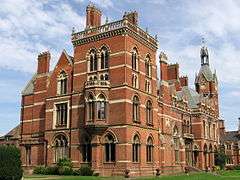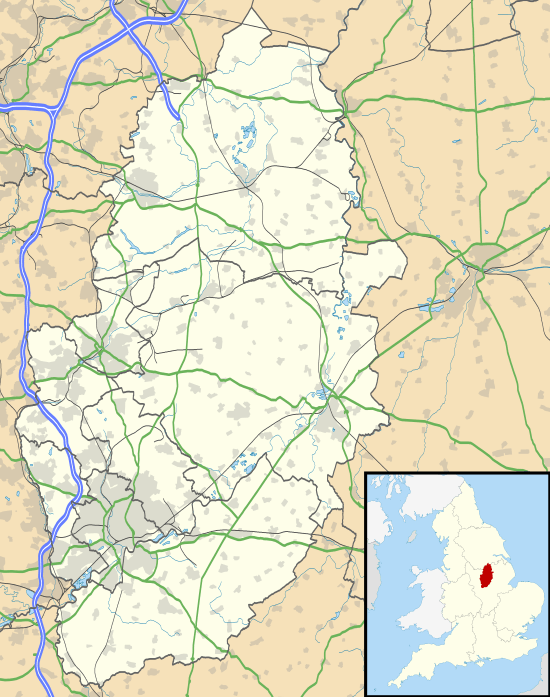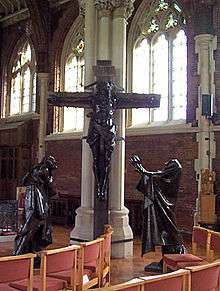Kelham
Kelham is a small village and civil parish in Nottinghamshire about 3 miles (4.8 km)[1][2][3] northwest of Newark on a bend in the A617 road near its crossing of the River Trent. The population of the civil parish taken at the 2011 census was 207.[4]
| Kelham | |
|---|---|
 Kelham Hall | |
 Kelham Location within Nottinghamshire | |
| Population | 207 (2011) |
| OS grid reference | SK7755 |
| Civil parish |
|
| District | |
| Shire county | |
| Region | |
| Country | England |
| Sovereign state | United Kingdom |
| Post town | Newark |
| Postcode district | NG23 |
| Police | Nottinghamshire |
| Fire | Nottinghamshire |
| Ambulance | East Midlands |
| UK Parliament | |
Historical
Kelham is "a small but pleasant village and parish, upon the Worksop Road, and on the west bank of the Trent, 2 miles (3.2 km) north-west of Newark. Its parish contains 208 inhabitants and 1,800 acres (7.3 km2) of land, of which 484 acres (1.96 km2) are on the island formed by the two rivers betwixt it and Newark. It has long been the seat and property of the Suttons, who once held the title of Lord Lexington. It is now the property of John Henry Manners Sutton Esq., who resides at the Hall, which is a plain but elegant building, with a centre and wings of brick, with stone corners and window frames, standing in a handsome lawn, near the Trent.
"A curious wooden bridge which crosses the river close to the lawn has been taken down, and a light but substantial iron bridge erected in its place at a cost of £3,000. The church dedicated to St. Wilfred, had a handsome tower and three bells. It was new-roofed and completely renovated in 1844. Here is a richly wrought monument of the last Lord Lexington and his Lady, of fine statuary marble, but the figures are strangely placed back-to-back. The living is a rectory, valued in the King's books at £19 8s 4d, annexed to that of Averham, being in the same patronage and incumbency. The poor have the interest of £25 left by an unknown donor."[5]
Kelham Hall
Kelham Hall was originally the home of the Manners-Sutton family (a family connected to the Dukes of Rutland, the Marquess of Granby, and Viscount Canterbury) of Averham.[6] It is a Grade I listed building standing in 52 acres of parkland. The listing (1973, updated in 1990) included this summary: "Gothic revival style. 1859-61 ... Incorporates service range, 1844-46 by A. Salvin ... Service range in Renaissance revival style. Brick and ashlar with ashlar dressings, gabled, hipped and pyramidal slate roofs" and that it had been modified in the 19th and 20th century.[7] The "Former monastic buildings and chapel", adjoining Kelham Hall, which "had been converted to offices and function room", have been Grade II listed since 1990.[8]
The Kelham estate was first acquired by William Sutton from the Foljambe family. "On 5 May 1647, King Charles I surrendered at the end of the English Civil War at nearby Southwell and was held at Kelham Hall for several days afterwards."[9] The Hall was upgraded by William's son Robert Sutton, 1st Baron Lexinton after the Civil War. This first house was destroyed by fire in the reign of William and Mary.
Its replacement was built c.1730 by John Sanderson for Bridget, the Duchess of Rutland, the only surviving child of the second Lord Lexington. She had married John Manners, 3rd Duke of Rutland and their descendants would be known by the name of Manners-Sutton. This building was also destroyed by fire on 27 November 1857, during the Victorian era when the owner was in Italy, and would again be rebuilt.
The third and present Kelham Hall "is considered a masterpiece of high Victorian Gothic architecture, entirely asymmetrical, with a gloriously irregular skyline, and crowning 'grandiloquent' towers."[10] It was designed by Sir George Gilbert Scott and completed in 1863. Not long after the fire, "a new Kelham Hall, of magnificent proportions, and of an architectural beauty far superior to that possessed by its predecessors, either at Kelham or Averham was erected in the Italian style... and is justly said to be one of (Scott's)...most successful works."[11] In 1865 Gilbert Scott reused many of the design details of Kelham Hall on a much larger scale for the façade of the Midland Grand Hotel at St Pancras railway station in London, completed in 1876.

The Manners-Sutton family then ran into financial difficulties and the Hall was sold to the Society of the Sacred Mission in 1903 and run as a theological college. It was occupied by military forces during World War I. The Great Chapel "was dedicated in 1928 and was a masterpiece. It was almost square with a great central dome, (62 feet across and 68 feet (21 m) high), the second largest concrete dome in England. A few visitors said it reminded them of Stonehenge – massive, austere and mysterious."[12]
A bronze sculpture, known as 'the Kelham Rood', depicting Christ on the Cross accompanied by figures of St John and the Virgin Mary was commissioned from the English sculptor Charles Sargeant Jagger to adorn the chapel in 1927, and was completed in 1929. "The main accommodation building at the front of the Hall was completed in 1939 to house the Monks and the theological students but its first occupants were a garrison of the 'Blues' cavalry and also Texas and Oklahoma oil men who were involved in drilling for oil at the nearby Eakring oilfield."[9] The Hall was again occupied by military personnel during World War II.
The Society of the Sacred Mission theological college closed in 1972 due to declining numbers.[13] The chapel was desanctified.
Recent history
In 1973, the Hall became the head office of Newark and Sherwood District Council. Jagger's Kelham Rood sculpture was removed and re-erected at Willen Priory in Milton Keynes, where it stood in the garden until 2003 when it underwent restoration and was moved to the Church of St John the Divine, Kennington, in London.
Kelham Hall was sold to Jonathan Pass in 2014[14] who formed a private company, Kelham Hall Ltd; he had previously held a temporary leasehold on the ground floor. In May 2015 Newark and Sherwood Concert Band moved its rehearsal base to Kelham Hall and now rehearses there weekly in the Dome.
The new owner took full possession after Newark & Sherwood District Council moved out of Kelham Hall into a new building close to Newark town centre in 2017.[15]
The Hall was to become a prestigious hotel, conference centre and health spa, according to Jonathan Pass, managing director of Kelham Hall Ltd.[16][17] Initially, Pass began redeveloping Kelham Hall & Country Park into a venue for weddings and conferences;[18] that use commenced after planning consent was obtained. No overnight accommodations were offered.[19][20]
The conversion to a hotel was not completed; an October 2019 news item indicated that Averham, Kelham and Staythorpe Parish Council had some objections to such a large hotel, since the previous application had proposed 71 bedrooms.[21] By June 2020, however, another news source stated that the building was "ready to be used as a 103-bed hotel and spa with full planning consent to do so".[22] Also in June 2020, the Corporate Hotels division of Christie & Co began to market Kelham Hall for sale with a guide price of £10 million, as a development opportunity: "a chance to create what could be one of the best hotels in the country".[23]
Notable people
- Robert Sutton (1813-1885), first-class cricketer and reverend
Notes
- Local Council webpage
- Penny Farthing Fairs
- Taxis & minicabs in Newark – UpMyStreet Archived 28 September 2007 at the Wayback Machine
- "Civil parish population 2011". Neighbourhood Statistics. Office for National Statistics. Retrieved 11 April 2016.
- White's Directory of Nottinghamshire 1853
- Nottinghamshire: history and archaeology | Link's with Old Nottingham: Southwell: The Saracen's Head
- Kelham Hall List Entry Number 1045982
- Former Monastic buildings adjoining Kelham Hall
- FTS Kelham Hall Archived 30 September 2007 at the Wayback Machine
- Tim Warner article Archived 1 October 2006 at the Wayback Machine
- Brown, 1896
- The Society of the Sacred Mission
- The Society of the Sacred Mission
- BBC on the sale of Kelham Hall
- Businessman finalises purchase of Kelham Hall for wedding venue and boutique hotel 3 January 2018
- Grade I-listed Kelham Hall conversion 'will create 80 jobs'
- NSDC Update
- Businessman finalises purchase of Kelham Hall for wedding venue and boutique hotel 3 January 2018
- Kelham Hall & Country Park
- Kelham Hall
- Kelham Hall will now be a 103-bedroom hotel — an increase on the original 71 bedrooms
- Magnificent stately home goes up for sale for a staggering price
- Kelham Hall put up for sale for £10m after two years
External links
| Wikimedia Commons has media related to Kelham. |